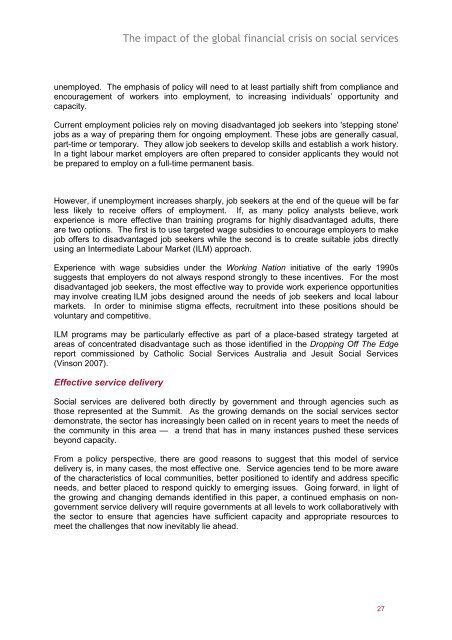The impact of the global financial crisis on social services in Australia
The impact of the global financial crisis on social services in Australia
The impact of the global financial crisis on social services in Australia
You also want an ePaper? Increase the reach of your titles
YUMPU automatically turns print PDFs into web optimized ePapers that Google loves.
<str<strong>on</strong>g>The</str<strong>on</strong>g> <str<strong>on</strong>g>impact</str<strong>on</strong>g> <str<strong>on</strong>g>of</str<strong>on</strong>g> <str<strong>on</strong>g>the</str<strong>on</strong>g> <str<strong>on</strong>g>global</str<strong>on</strong>g> <str<strong>on</strong>g>f<strong>in</strong>ancial</str<strong>on</strong>g> <str<strong>on</strong>g>crisis</str<strong>on</strong>g> <strong>on</strong> <strong>social</strong> <strong>services</strong><br />
Underly<strong>in</strong>g<br />
cash balance<br />
TABLE 3.4: SUMMARY OF BUDGET AGGREGATES, 2008-09 TO 2011-12<br />
2008-09<br />
(Budget<br />
estimate)<br />
2008-09<br />
(Revised<br />
estimate)<br />
2009-10<br />
(Budget<br />
estimate)<br />
2009-10<br />
(Revised<br />
estimate)<br />
2010-11<br />
(Revised<br />
estimate)<br />
2011-12<br />
(Revised<br />
estimate)<br />
$21.7b $5.4b $19.7b $3.6b $2.6b $6.7b<br />
% <str<strong>on</strong>g>of</str<strong>on</strong>g> GPD 1.8 0.4 1.5 0.3 0.2 0.5<br />
Fiscal balance $23.1b $5.8b $22.4b $7.1b $6.7b $10.1b<br />
% <str<strong>on</strong>g>of</str<strong>on</strong>g> GDP 1.9 0.5 1.7 0.6 0.5 0.7<br />
Source: Federal Treasury (2008:4)<br />
3.2 KEY IMPACTS ON LOW-INCOME HOUSEHOLDS<br />
<str<strong>on</strong>g>The</str<strong>on</strong>g> forecast for <strong>Australia</strong>’s ec<strong>on</strong>omy outl<strong>in</strong>ed above pa<strong>in</strong>ts a picture <str<strong>on</strong>g>of</str<strong>on</strong>g> slow<strong>in</strong>g ec<strong>on</strong>omic<br />
growth and ris<strong>in</strong>g unemployment coupled with fall<strong>in</strong>g <strong>in</strong>flati<strong>on</strong> and decl<strong>in</strong><strong>in</strong>g <strong>in</strong>terest rates.<br />
Invariably however, different segments <str<strong>on</strong>g>of</str<strong>on</strong>g> <str<strong>on</strong>g>the</str<strong>on</strong>g> ec<strong>on</strong>omy and society will be affected <strong>in</strong><br />
different ways. Some will be hit disproporti<strong>on</strong>ately hard, while o<str<strong>on</strong>g>the</str<strong>on</strong>g>rs may benefit (primary<br />
producers, for example, who ga<strong>in</strong> from <strong>in</strong>creased returns associated with <str<strong>on</strong>g>the</str<strong>on</strong>g> depreciat<strong>in</strong>g<br />
<strong>Australia</strong>n currency).<br />
Draw<strong>in</strong>g <strong>on</strong> <str<strong>on</strong>g>the</str<strong>on</strong>g> broad c<strong>on</strong>clusi<strong>on</strong> above, and as a precursor to <str<strong>on</strong>g>the</str<strong>on</strong>g> discussi<strong>on</strong> <str<strong>on</strong>g>of</str<strong>on</strong>g> <strong>social</strong><br />
<strong>services</strong> <strong>in</strong> <strong>Australia</strong>, this secti<strong>on</strong> outl<strong>in</strong>es some <str<strong>on</strong>g>of</str<strong>on</strong>g> <str<strong>on</strong>g>the</str<strong>on</strong>g> key <str<strong>on</strong>g>impact</str<strong>on</strong>g>s fac<strong>in</strong>g low—<strong>in</strong>come<br />
households as a result <str<strong>on</strong>g>of</str<strong>on</strong>g> recent ec<strong>on</strong>omic c<strong>on</strong>diti<strong>on</strong>s and <str<strong>on</strong>g>the</str<strong>on</strong>g> ec<strong>on</strong>omic outlook.<br />
<br />
Ris<strong>in</strong>g unemployment<br />
As noted, slow<strong>in</strong>g ec<strong>on</strong>omic growth will see unemployment rise, and employment shift<br />
towards part-time and casual positi<strong>on</strong>s. Be<strong>in</strong>g closely correlated with household <strong>in</strong>come,<br />
employment has a major bear<strong>in</strong>g <strong>on</strong> welfare. As employment levels fall <str<strong>on</strong>g>the</str<strong>on</strong>g>refore, and as <str<strong>on</strong>g>the</str<strong>on</strong>g><br />
compositi<strong>on</strong> <str<strong>on</strong>g>of</str<strong>on</strong>g> employment shifts towards part-time and casual positi<strong>on</strong>s, <strong>in</strong>creas<strong>in</strong>g<br />
numbers <str<strong>on</strong>g>of</str<strong>on</strong>g> households will f<strong>in</strong>d <str<strong>on</strong>g>the</str<strong>on</strong>g>mselves under <str<strong>on</strong>g>f<strong>in</strong>ancial</str<strong>on</strong>g> stress and <strong>social</strong>ly excluded. At<br />
<str<strong>on</strong>g>the</str<strong>on</strong>g> same time, those who are currently unemployed will face greater competiti<strong>on</strong> from<br />
recently redundant workers, and <str<strong>on</strong>g>the</str<strong>on</strong>g>refore face greater challenges f<strong>in</strong>d<strong>in</strong>g employment. With<br />
workers who have recently exited <str<strong>on</strong>g>the</str<strong>on</strong>g> workforce likely to be more attractive to employers<br />
when c<strong>on</strong>diti<strong>on</strong>s improve, particularly relative to <str<strong>on</strong>g>the</str<strong>on</strong>g> l<strong>on</strong>g-term unemployed, <str<strong>on</strong>g>the</str<strong>on</strong>g> pend<strong>in</strong>g<br />
ec<strong>on</strong>omic slowdown will also <str<strong>on</strong>g>impact</str<strong>on</strong>g> heavily <strong>on</strong> those who are already fac<strong>in</strong>g significant<br />
barriers to f<strong>in</strong>d<strong>in</strong>g employment.<br />
<br />
Susta<strong>in</strong>ed hous<strong>in</strong>g cost <strong>in</strong>creases<br />
Recent str<strong>on</strong>g ec<strong>on</strong>omic growth has seen <str<strong>on</strong>g>the</str<strong>on</strong>g> costs <str<strong>on</strong>g>of</str<strong>on</strong>g> hous<strong>in</strong>g — both house prices and<br />
rents — <strong>in</strong>crease str<strong>on</strong>gly <strong>in</strong> all capital cities and <strong>in</strong> many regi<strong>on</strong>al and rural areas. Spurred<br />
to some extent by str<strong>on</strong>g performance <strong>in</strong> o<str<strong>on</strong>g>the</str<strong>on</strong>g>r asset classes, <str<strong>on</strong>g>the</str<strong>on</strong>g> partly <strong>in</strong>vestor-driven,<br />
partly demography-driven <strong>in</strong>crease <strong>in</strong> house prices has seen a rise by an average <str<strong>on</strong>g>of</str<strong>on</strong>g> 73%<br />
s<strong>in</strong>ce 2002.<br />
At <str<strong>on</strong>g>the</str<strong>on</strong>g> same time, and reflect<strong>in</strong>g <str<strong>on</strong>g>the</str<strong>on</strong>g> difficulties many have faced <strong>in</strong> attempt<strong>in</strong>g to enter <str<strong>on</strong>g>the</str<strong>on</strong>g><br />
hous<strong>in</strong>g market, rents have also grown c<strong>on</strong>siderably, <strong>in</strong>creas<strong>in</strong>g by 27% over <str<strong>on</strong>g>the</str<strong>on</strong>g> same<br />
period as <str<strong>on</strong>g>the</str<strong>on</strong>g> average occupancy rate across <str<strong>on</strong>g>the</str<strong>on</strong>g> nati<strong>on</strong> has fallen (Figure 3.6).<br />
14



